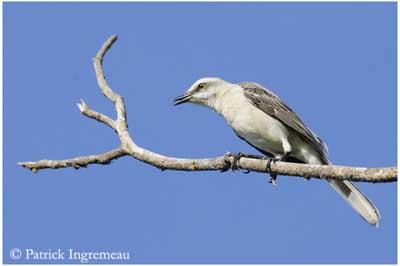
Tropical Mockingbird
Mimus gilvus
Passeriforme Order – Mimidae Family
BIOMETRICS:
Length: 23-25, 5 cm
Weight: 54 g
DESCRIPTION:
Tropical Mockingbird adult has grey head and upperparts. Wings are blackish with two conspicuous white wing bars, and white edges on flight feathers. Long tail is blackish with white broad tips on outer feathers. Underparts are white.
Forehead, crown and nape are grey. Face is paler with whitish cheeks and dusky lores. Black bill is slim and slightly down curved. Eyes are yellow and we can see a broad grey-white eyeline. Long legs and feet are blackish.
Both sexes are similar.
Fr: Moqueur des savanes
All : Tropenspottdrossel
Esp : Sinsonte Tropical
Ital : Mimo tropicale
Photographs by Patrick Ingremeau
His website:
TAMANDUA
Photograph by Steve Garvie
His website: RAINBIRDER Photo galleries
Photograph by Marc Chrétien
His website:
MURINUS
Text by Nicole Bouglouan
Sources :
A GUIDE TO THE BIRDS OF COLOMBIA by Steven L. Hilty and William L. Brown
Princeton University Press – ISBN 069108372X
HANDBOOK OF THE BIRDS OF THE WORLD Vol. 10 by Josep del Hoyo-Andrew Elliott-David Christie - Lynx Edicions - ISBN: 8487334725
A GUIDE TO THE BIRDS OF MEXICO AND NORTHERN CENTRAL AMERICA by Steve N. G. Howell, Sophie Webb - Oxford University Press - ISBN: 0198540124
Wikipedia (Wikipedia, The Free Encyclopedia)

Juvenile is duller and browner than adults and underparts are slightly spotted with pale brown on chest and flanks. Eyes are dusky.

We can find several subspecies:
M.g. antelius from eastern Brazil;
M.g. antillarum from West Indies;
M.g. tobagensis from Trinidad and Tobago;
M.g. melanopterus from northern South America;
M.g. rostratus from islands north of Venezuela;
M.g. tolimemsis from Colombia;
M.g. gracilis from southern Mexico to Central America;
M.g. leucophaeus from Yucatán Peninsula.
They differ in size and plumage.
VOICE: SOUNDS BY XENO-CANTO
Tropical Mockingbird’s song is a long rolling series of buzzy and clear whistled syllables. Calls include a hard “chek” or “shahk”.
Its song resembles Northern Mockingbird’s song (Mimus polyglottos).
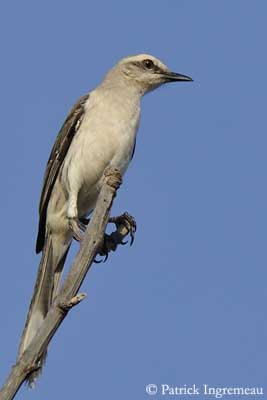
HABITAT:
Tropical Mockingbird lives in open habitats, farmlands, human habitation. It can be found from sea level to 2500 metres of elevation in Guatemala and Colombia, in cleared areas.
RANGE:
Tropical Mockingbird is resident from southern Mexico to northern Brazil, and in West Indies and other Caribbean Islands. Species have been introduced in Panama and Trinidad, but they are distinctive species.
BEHAVIOUR:
Tropical Mockingbird feeds on invertebrates. It forages on the ground and among vegetation. It also may fly down from a perch to catch insects. This bird can take food on tables or in plates.
It often spreads its wings when foraging, displaying the white wing bars. It may be aggressive towards other species on bird feeders. It runs around grassy areas, and raises its wings above its back after running. This species likes open spaces.
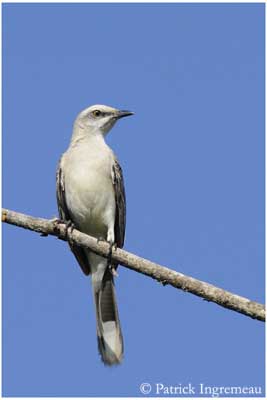
Tropical Mockingbird sings from the top of bushes. It sings mainly in the early morning, but it also sings during the hottest moments of the day, and may sing sometimes during the night.
Tropical Mockingbird is territorial and defends the nest against intruders and predators, including other birds, mammals and other animals such as iguanas, dogs or mongooses.
When nest building starts, male utters prolonged songs, while it builds the nest. Then, female helps it. When female doesn’t help the male, the nest is abandoned and male has to search other place.
They are monogamous and territorial all year round.
REPRODUCTION:
Tropical Mockingbird builds its nest in thick bushes or shrubbery. It is an open cup made with sticks and rootlets, at no great height, about 2, 50 to 3 metres.
Female lays 2 to 3 bluish eggs, spotted with reddish-brown. Incubation lasts about 13 to 15 days, by female. Male defends the nest. Chicks are fed by both parents.
This species may produce two broods per season. They nest during the rainy period, in order to get food resources, mainly insects and fruits.
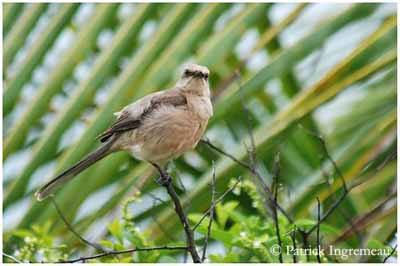
Nests are sometimes parasitized by the Shiny Cowbird (Molothrus bonariensis). Tropical Mockingbird accepts the eggs. Explanation says that if the Mockingbird ejects the intruder’s eggs, it may also eject or damage its own eggs. Some nests can contain up to 8 eggs of Shiny Cowbird. Strange fact, cowbirds do not parasitize the second broods, probably according to the food resources of this period. However, about 80% of Tropical Mockingbird’s nests are parasitized during the first period, from April to June. Reproduction success is about 20% in April-June, and up to 80% in October. But it may vary according to the region.
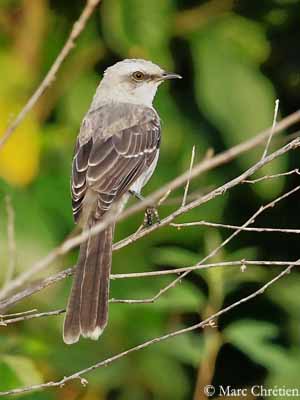
DIET:
Tropical Mockingbird feeds on insects, caterpillars, spiders, but also seeds and berries.
PROTECTION/THREATS/ STATUS:
Tropical Mockingbird is a popular species as cage-birds, and their nests are parasitized by Shiny Cowbirds. But this species has probably benefited from some human works, as clearance of forests and well-watered suburbs. It may be common and abundant in suitable habitat.